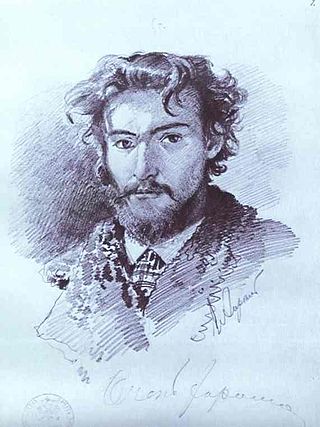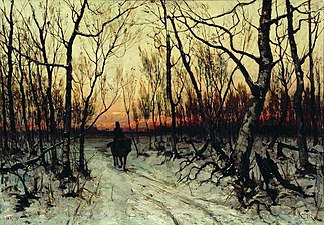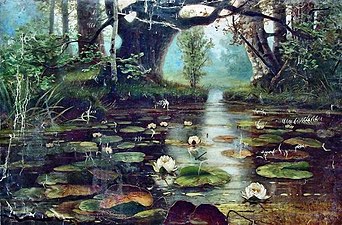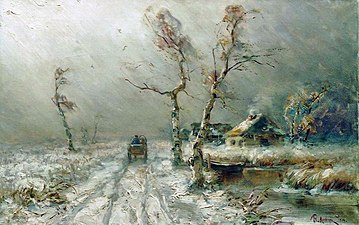
Ilya Yefimovich Repin was a Russian painter who was born in what is now Ukraine. He became one of the most renowned artists in Russia in the 19th century. His major works include Barge Haulers on the Volga (1873), Religious Procession in Kursk Province (1880–1883), Ivan the Terrible and His Son Ivan (1885); and Reply of the Zaporozhian Cossacks (1880–1891). He is also known for the revealing portraits he made of the leading Russian literary and artistic figures of his time, including Mikhail Glinka, Modest Mussorgsky, Pavel Tretyakov, and especially Leo Tolstoy, with whom he had a long friendship.

Vasily Ivanovich Surikov was a Russian realist history painter. Many of his works have become familiar to the general public through their use as illustrations.

Ivan Konstantinovich Aivazovsky was a Russian Romantic painter who is considered one of the greatest masters of marine art. Baptized as Hovhannes Aivazian, he was born into an Armenian family in the Black Sea port of Feodosia in Crimea and was mostly based there.

Arkhip Ivanovich Kuindzhi was a Russian landscape painter of Greek descent.

Karl Pavlovich Bryullov, also Briullov or Briuloff, born Charles Bruleau was a Russian painter. He is regarded as a key figure in transition from the Russian neoclassicism to romanticism.

Viktor Mikhaylovich Vasnetsov was a Russian artist who specialised in mythological and historical subjects. He is considered a co-founder of Russian folklorist and romantic nationalistic painting, and a key figure in the Russian Revivalist movement.

Mikhail Vasilyevich Nesterov was a Russian and Soviet painter; associated with the Peredvizhniki and Mir iskusstva. He was one of the first exponents of Symbolist art in Russia.

Nikolay Nikanorovich Dubovskoy was a Russian landscape painter, associated with the Peredvizhniki. Together with Isaac Levitan, he helped create what came to be known as the "Landscape of Mood".

Alexei Kondratyevich Savrasov was a Russian landscape painter and creator of the lyrical landscape style. The most famous and a celebrated work is The Rooks Have Returned.

Fyodor Alexandrovich Vasilyev was a Russian Imperial landscape painter who introduced the lyrical landscape style in Russian art.

Alexei Ivanovich Korzukhin was a Russian genre painter.

Ilya Semyonovich Ostroukhov was a Russian landscape painter and art collector, associated with the Peredvizhniki.

Alexey Petrovich Bogolyubov was a Russian landscape and seascape painter.

Pavel Aleksandrovich Svedomsky was a Russian painter and the brother of another artist, Alexander Svedomsky.

Alexander Mikhailovich Lyubimov was a Russian and later Soviet realist painter, graphic artist, illustrator, and art teacher, professor of Repin Institute of Arts and Vera Mukhina Higher School of Art and Industry, who lived and worked in Leningrad. He was a member of the Leningrad Union of Artists and regarded as one of founder and the brightest representatives of the Leningrad school of painting, most famous for his portrait paintings and satirical drawings.

Georg Wilhelm Timm, also known as Vasily Fyodorovich Timm, was a Baltic German painter, lithographer and ceramic designer, known for his genre and battle scenes. He was also the publisher of the Russian Art Gazette.

Sokrat Maksimovich Vorobyov was a Russian landscape painter, engraver and art teacher.
Klavdi Petrovich Stepanov (1854-1910) was a Russian Empire painter and monarchist publicist.

Pavel Antonovich Rizzoni, or Paolo Rizzoni was a Russian genre painter and graphic artist of Italian ancestry.

Longin Khristianovich Frikke was a Russian landscape painter.





























